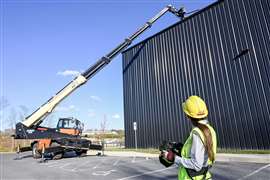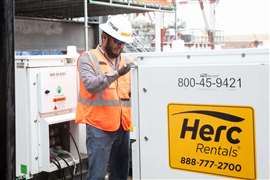Read this article in Français Deutsch Italiano Português Español
SAIA Canada Council provides update
16 May 2025
The Scaffold & Access Industry Association’s Canadian Council is in the midst of reviewing more than 100 documents and tools to determine current applicability/suitability for the Canadian market. We sat down with Chair Rick McKinlay for an update.
Over the past 12 months, what has the council been actively working on?
Since we last caught up, the Canadian Council has shifted focus and seen some exciting growth in terms of participation. After last year’s Convention in Denver, SAIA staff had put out a call for interested volunteers, which was super helpful. We were able to see our numbers increase from about a dozen regular participants to a grand total of 30 at time of writing. This includes 17 observers and 13 actively involved in our current project. Our roster includes 23 Canadians, with the others coming from the U.S., and even one from the UK.
 Rick McKinlay. (Photo: SAIA)
Rick McKinlay. (Photo: SAIA)
The council meets monthly via Teams (1st Wednesday) – additional callers and participants are always welcomed, even if it’s just to check out what’s going on.
Shortly after Convention, we began tackling a review of the current documents and tools available from the various other SAIA Councils (a total of about 108 documents, not including alternative language translations), with an eye to determine current applicability/suitability for the Canadian market.
Each document or tool is reviewed by an assignee, and an assessment is made as to whether it is universally applicable (i.e., OK for use on either side of the border), requires a degree of language change to make it universally applicable (e.g., referencing Canadian codes and standards alongside U.S.), or if an all-new “Canadian” version is required.
In the latter two cases, drafts of the suggested language changes or draft new documents are provided if the required changes are significant enough to warrant a stand-alone Canadian version.
These drafts are then submitted into to the SAIA’s Regulatory and Review (R&R) process for finalization and publication.
At writing, we have 40 of the 108 documents having completed Canadian Council review (37 percent), and 14 in progress and assigned (13 percent). 15 documents are undergoing R&R review towards approval and finalization, and 4 have additionally been submitted for R&R review directly by their respective Council Chairs.
At our monthly calls, we review the status of our individual assignments, and then if completed go back to the pile to grab another ahead of the next month’s call. Eating this elephant one mouthful at a time and the cadence of our recurring meetings and status updates have certainly helped keep the momentum going strong.
Looking forward, what will the council be focusing on for the next 12 months and/or what are the council’s main goals and objectives for the coming year?
Having tackled almost 50 percent of the documents and tools in under a year, the Council plans to keep going strong with a goal of having 100 percent of the Canadian Council reviews in time for the 2026 Convention in Nashville.
Will we see any changes to the council in next year? If so, what? Why?
The Canadian Council doesn’t anticipate any major changes to the council in the coming year. As always, we do encourage any of those interested to get involved with the council, attend our meetings and sessions – as with anything, you get out of it what you put into it. I don’t think that we could have too many volunteers!
Are there any upcoming changes to standards/regulations that will impact scaffolding in Canada?
No specific changes come to mind, but a few of the Canadian Standards Association (CSA) Technical Committees are known to be meeting towards review and re-publication of updated versions of those standards.
With the breadth of the participants in the Canadian Council (with representatives in the majority of the Canadian Provinces and beyond), we’re confident that any upcoming changes to regulations, codes, and standards would be on the radar of our members and consequently communicated to the council for providing head’s up to any interesting parties, as well as to drive any necessitated changes as a result.
Anything else?
As always, the Canadian Council remains an available resource for any of the other SAIA members or councils – if there are ways that the council can contribute and provide insight or an alternate perspective on any of the projects being undertaken or issues being experienced in the field, don’t hesitate to get in touch with the Council Chairs – we’re here for your benefit.sa
STAY CONNECTED



Receive the information you need when you need it through our world-leading magazines, newsletters and daily briefings.
CONNECT WITH THE TEAM












